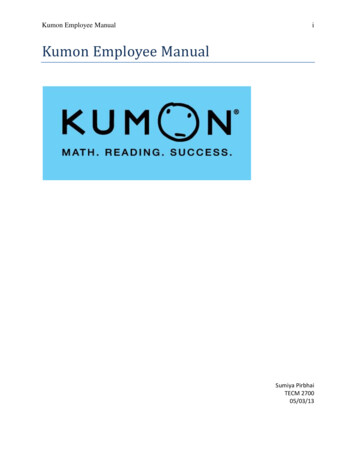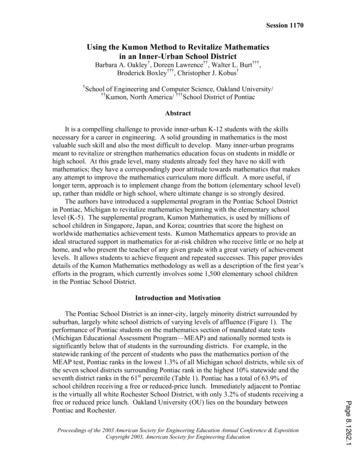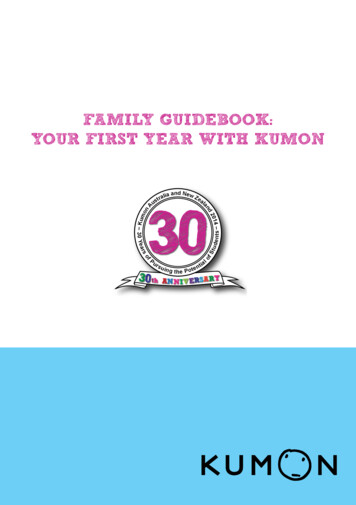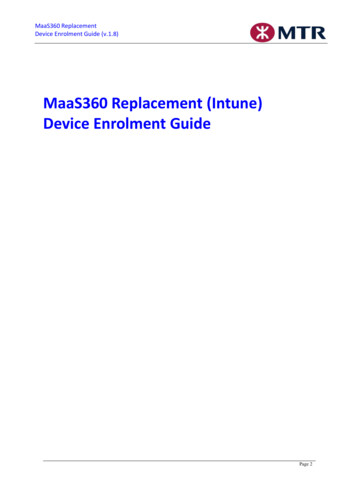
Transcription
ContentAbout Kumon . p3The KumonWorksheets . p4The Kumon Instructor. p5Study Flow . p6Math Program. p8Reading Program. p9Kumon Aroundthe World. p112
about KumonThe world’s largest after-schoollearning programOne father’s love for his son gave birth to theKumon Method of Learning. In 1954, Toru Kumon,a high school math teacher in Japan, createdhandmade math worksheets for his son in secondgrade of elementary school to steadily develop hiscalculation skills. As a result, he was able to reachthe level of differential and integral calculus whenhe was just a few months into the sixth grade.After more than half a century, his philosophycontinues to spread globally and now helpsmore than 4 million students develop the abilityto achieve their goals and dreams. Right at thismoment, someone, somewhere around the worldis learning through the Kumon Method of Learning.In Kumon, we believe in the potential of each andevery child. Children can advance irrespective oftheir age or school grade level. Each time childrenindependently confront a challenge they havenever known or experienced before, they undergoa process where their ability development ismaximized with a strong sense of achievement.3
The Kumon WorksheetsSelf-learning is facilitated by the constantly evolving worksheetsTopics in Kumon worksheets are structured to allow progression insmall stepsKumon worksheets are structured to allow progression in small steps,enabling each student to advance smoothly from easy to difficultproblems and ultimately toward studying advanced high school levelmaterials on their own.Worksheets are revised through learning from studentsSince the original worksheets were createdby Toru Kumon in 1954, informationsuch as students’ reactionsto the worksheets andfeedback from Instructorshave been continuallytaken into account whenrevising worksheets. Bylearning from students andInstructors, the worksheets arecontinually improved to be moreeffective for self-learning.4
THE KUMON INSTRUCTORThe role of a Kumon Instructor is to bring out thepotential in each individualThe Kumon worksheets are designed to allow studentsto advance through self-learning. Nonetheless, there aretimes when students encounter problems that they don’tunderstand or are unable to solve on their own.At times like these, Kumon Instructors do not spoon-feedstudents with problem-solving methods. Rather, ourInstructors find out how much the students understandbefore giving them hints. Instructors may also show studentsexample problems or previously studied material to help themsolve difficult problems on their own. In doing so, students enjoy a sense ofachievement and are able to master new material independently.Kumon Instructors discover what each student is capable of and bring out thepotential in each and every one of them. Our Instructors focus on each studentindividually, paying careful attention to their academic ability, personality, andhow they solve the worksheets. Instructors then provide effective support toensure learning at a level that is “just-right” for each individual.Kumon Instructors acknowledge the growth of each student without comparisonto others, while offering praise and encouragement. At the same time,they cooperate closely with parents in monitoring the growth of each student.It is through these dedicated Instructors, who sincerely wish for the growth oftheir students, that the true benefits of the Kumon Method are achieved.5
Study FlowBelow is a typical study flow for Kumon students. Depending on the Center,there may be variations to the study flow.1 Receiveclasswork- Upon arrival,your childwill submitcompletedhomework andreceive materials tocomplete at the Center.63 Submit classwork- Your child willsubmit completedworksheets formarking.2 Study in class- At the Center, your child willcomplete the assigned worksheets.- The duration for classwork dependson the contents of the worksheetsassigned for the day.- During the initial stages oflearning in Kumon, your childwill typically take 30 minutesfor each subject.
Mathresults5 Recordof study- Completion timesand scores foreach worksheet willbe recorded.- Should your child study more thanone subject, the same routinefrom steps 1 to 5 will be applied.mistakes and4 Correctget 100 marks- Your child will correct his orher mistakes if thereare any, which willthen be marked.- This allowsyour child toget 100 marksfor everyworksheetcompleted.Reading7 Do worksheets at home- Your child shouldcomplete theassignedhomework inan environmentthat allows fullconcentration.6 Bring worksheets home- To maximize learningand develop goodstudy habits,worksheets areassigned ashomework fornon-center days.7
Math ProgramDevelop ability to self-learn senior high school mathOMath is a subject that requires an accumulation ofknowledge through practice. With the aim of studyingsenior high school math (differential and integral calculus)with ease, students enhance their calculation skills,cultivate their mathematical analysis, and developlogical thinking abilities. This leads them to developthe ability to solve various problems that they will facein the future.NMThe Math Program consists of 20 Levels,from Level 6A through to Level O, and 5elective courses. The worksheets focus onthe development of strong calculation skillswhich enables students to apply to othermathematical concepts. By avoiding allunrelated concepts, theprogram aims to allowstudents to advance asquickly as possible ontheir own to differentialand integral calculus.8GFEDCBA2A3A4A5A6ALoci, Sequences and Series,Limits of Functions, DifferentiationTrigonometry, Straight Lines, CirclesLogarithms, CalculusLK Functions—Quadratic, Fractional,Irrational, ExponentialJIHFeatures of Math ProgramAdvanced Differentiation andIntegration, Differential EquationsBasic High School AlgebraFactorization, Square Roots, QuadraticEquations, the Pythagorean TheoremSimultaneous Equations,Inequalities, Functions and GraphsPositive/Negative Numbers,Introduction to AlgebraFour Operations of Fractions, DecimalsFractionsLong Multiplication, Long Division,Introduction to FractionsMultiplication, DivisionVertical Addition and SubtractionHorizontal Addition and SubtractionBasic AdditionWriting Numbers up to 120,Introduction to AdditionWriting Numbers up to 50Reading Numbers up to 50Reading Numbers up to 10
Reading PROGRAMLearn how to support an opinion using informationfrom a passage through analyzing and interpretingelements of literature.ReadingcriticallyEnhance critical reading ability by writing a commenton a passage from an objective standpoint.Develop high-level reading abilityIn the Reading Program, we aim tocultivate high-level reading abilitywithin all students. Throughimproving students’ readingcomprehension skills to a highlevel, students acquire thenecessary mindset to read passagescritically. By focusing on developingreading ability through exposure to awide range of books, students acquire greater interestin reading which facilitates learning advanced materialswith independence and confidence.Features of Reading ProgramThe Reading Program begins by enrichingstudents’ vocabulary and developing basic readingskills. Students move on to learn about sentencestructure, paragraph building, summarization,and critical reading. They develop their readingcomprehension skills through the Kumon Methodof summarization. This embodies the processthrough which students read a passage andrearrange each sentence in their own minds.II/IIIGI/GIIFI/FIIIdentifying thetopic of eachparagraphEI/EIIDI/DIICI/CIIVisualizinga passageBI/BIIAI/AII2ALearningto readand write3A4A5ARepeatingand recitingHI/HIISummarizing6A7AComplete a summary by restructuring pieces ofinformation in a paragraph and making the topicthe axis of the summary sentence.Summarize one paragraph of a passage independentlywhile being conscious of the context of several paragraphs.Explain the summary process.Comprehend and compose complex sentences.Read a passage while identifying the topic of each ofits paragraphs.Understand the links between sentences and paragraphs,and the links over paragraphs.Interpret a passage through restatement, examples and description.Comprehend and compose simple sentences.Visualize the contents of a passage by recognizing sequences,comparing ideas and identifying the 5Ws-1H (who, what, when,where, and how) elements within it.Improve oral reading ability and gradually start reading silently.Read aloud words and sentences by learning sound partswithin words.Read aloud and understand short passages.Improve letter-writing ability by tracing, copying and writing words.Repeat and recite words, phrases and short sentences.Associate spoken words with their written form.9
10
Kumon Around the worldppPhili inesSKumon teaches you two very important qualities in life. First, youhave to set a goal, and second, you need to work hard daily toachieve that goal. Kumon is a new way of learning in which youlearn on your own and rely on assistance only when required. Forme, that is also how one would learn in real life.Father of Carlos, 9 years oldaporeginDuring a major math exam, I did very well and got an A.I found the paper very easy because I did high level math inKumon. I feel very proud of studying at such a level because manyof my friends have not studied to my standard yet. For me, Kumonis a place that can help me now and in the future.Eric Lim, 13 years oldIndiaKumon takes away the fear of studying and helps you realizethat, you can do it! As soon as I have found out that I haveactually completed the Kumon Program, I felt really proud andhappy for myself. When my classmates ask me how I can be sogood at math, I always tell them, go to Kumon!Yuvraj, 12 years old11
1 Call/visit your nearest Kumon Center.JoinKumon2 Set an appointment for ParentOrientation.3 Attend a free Diagnostic Test andconsultation session with the Instructorto know how your child’s ability will bedeveloped through Kumon.P500Registration FeeMonthly Tuition Feeper SubjectNationalCapital RegionOther RegionsGrade 6 oryounger studentsP2,000P1,800Grade 7 / first yearhigh school orolder studentsP2,150P1,950Fees inclusive of 12% VATFor more information(02) 885-0226 Manila Office(032) 263-3419 Cebu Office1800-1888-0231 Toll-Freeph.kumonglobal.com 2018 Kumon Asia & Oceania Pte Ltd. All Rights Reserved.II01.PH.05.0218
Kumon Instructors discover what each student is capable of and bring out the potential in each and every one of them. Our Instructors focus on each student . Improve letter-writing ability by tracing, copying and writing words. Repeat and recite words, phrases and short sentences. Associate










